Black Dolls in My Heart
My relationship with Black dolls began when I was 7 years old. I remember that it was on a family trip to San Antonio, Texas, when I discovered a little doll that was only 7 cm in size in a toy shop. The doll was Black and I immediately had a strong connection with him, he was so small, he had no hair, and his head in proportion to his body was big, but he had beautiful eyes, I had to take him with me, I called him Scottie, and he became my companion everywhere.
We had many adventures together because I always took him with me. On a trip to Acapulco, we were on a boat and when passing a very big wave, Scottie fell into the sea. I remember screaming in anguish, “Scottie fell…” and my aunt Lili immediately jumped into the sea to rescue him, for luckily Scottie was floating and was able to be rescued.
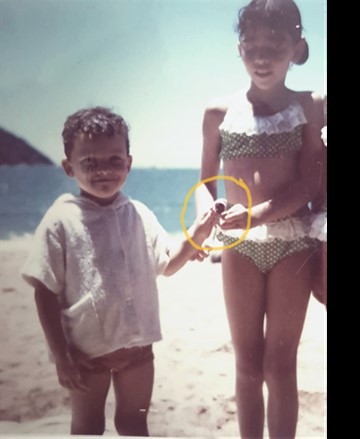
My mother made him clothes and I remember that for Christmas, in addition to me receiving gifts, Scottie also received little things. He was my only and most beloved doll throughout my entire elementary school years.
The interesting thing in this whole story is that in some way I identified with him, not only because of the color of my skin, because I was the only dark-skinned one of all my siblings (three sisters and two brothers), who were all very white-skinned just like my mother. However, my father was dark-skinned just like me, and like a large majority of Mexicans, since according to figures from the National Institute of Statistics and Geography (INEGI), in the 2020 census, 62.3% of the country’s population identified themselves as having dark to light brown skin, this tone being the predominant skin color in the country. So, it was normal for me to see these skin tones around me. However, I was the only one among my sisters and friends who had a Black doll. And despite being different, that made me feel special. I don’t remember having any comments of ridicule or rejection for having my Black doll, however, it was notorious that there were no Black dolls, at least in Mexico, which was where I grew up.
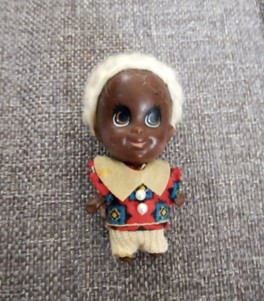
Throughout my life, my relationship and interest in collecting Black dolls, or artisan dolls, mainly handmade, has been huge. It is as if through them I have a deeper and more empathetic connection to the difficulties and injustices that women of color experience. It is as if they gave me the strength to join the fight for inequality and discrimination that has always existed. Because since my adolescence I have had an inherent strength to help minorities and defend human rights. It was during my adolescence that a great interest in social justice awoke in me and I discovered Steve Biko, a high school teacher and young South African anti-apartheid activist, who peacefully fought against discrimination and for equality in his country. I remember how much the Soweto massacre in 1976 impacted me, since I was the same age as many of the murdered teenagers and the iconic image of young Hector being carried bloody running through the streets remains in my memory. Since then, Steve Biko became a social and political leader in my life, his principles of fighting for social justice and racial discrimination forged ideas in my thinking that nourished my vision for the fight against inequalities and the defense of human rights.
My relationship with Black dolls continued when I became a mother, when one of my daughters, Jimena, similarly, in a toyshop in England, among a mountain of white dolls, noticed a Black doll, and I remember how she jumped to get it in her hands. My daughter Jimena was only 18 months old and I found it incredible to see her reaction of love and affection towards the doll. My daughter left the shop happy, hugging “Lakini” this was the name we gave her in Swahili. And from that moment on she was her adventure companion for many years.
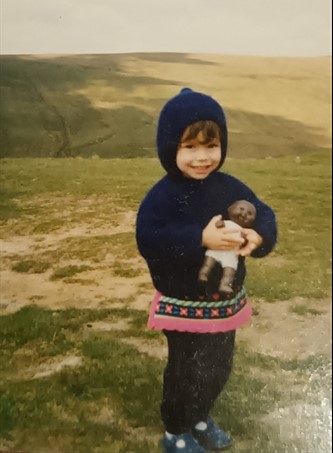
I find it very interesting how the experience and reaction that I had as a child towards Scottie was repeated in almost the same way with my daughter Jimena. Could it be that there is a genetic transmission from mother to daughter for love, empathy, interest, and affection for Black dolls? What drives the mind to decide which doll to choose? What lies beyond that choice? When choosing, there is the freedom to decide what I like and want. And that freedom is connected to a deeper feeling, which can be love, empathy, identity, or also dislike, or rejection. It is emotions that influence whether we feel like or dislike any object. This is attributed to the influence that the reptilian brain has on the limbic brain, which is responsible for instinctive thinking. So, what happens inside a girl’s thoughts to react with love towards the Black doll? Her intuition prompts her to choose the doll, but the feeling she expresses toward it comes from a deeper connection with her being.
In 2019, I had the opportunity to volunteer in Malawi with the civil association “Women Together. Inc.” While there, I proposed making dolls and selling them to obtain funds for the different projects of the women of Malawi. Projects that helped women have greater economic and emotional autonomy in their homes. In addition to showing the world the beauty and cultural wealth that exists in African countries.
During my volunteering in Malawi, I made 4 dolls as an example, and the idea was to support a group of women from the town of Blantyre, in the south of Malawi, who are known for their sewing work making quilts, when exposing the idea to them with great enthusiasm they agreed to participate and in this way they would help us produce these dolls.
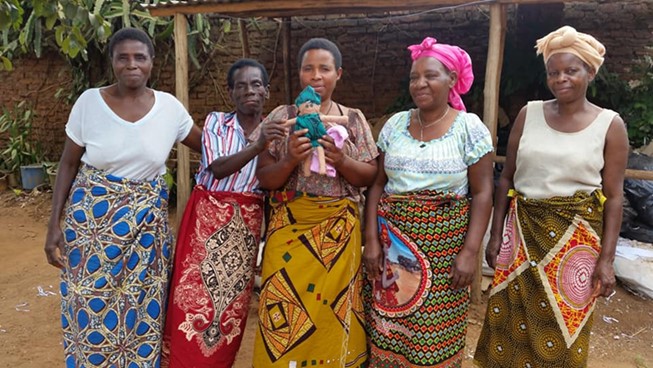
Unfortunately, my time as a volunteer ended, and the project was left pending. However, one person, one of the main donors of the Women Together Inc. association, wanted to buy the 4 dolls, so three of them were sent to the headquarters in New York and I kept one.
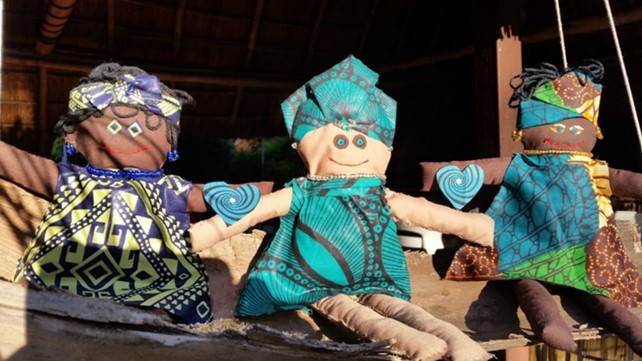

In 2022 I spent three months in Australia, and one of my activities was to make a black doll, to integrate it along with other of my works in an art exhibition that was held in a gallery in the city of Melbourne. The exhibition was open for two months and it was very interesting to note the interest and curiosity of the Australian community to learn more about the history of the Black doll. An elderly woman with white skin was delighted with the doll and bought it. She told me that it would be a gift for her granddaughter because she wanted her to grow up feeling love for all races, regardless of color.
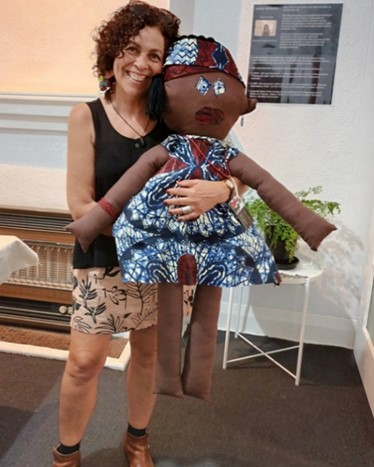
The relationship and great interest that I have always had in collecting black dolls, or handmade dolls, have been the origin of my style in the art that I develop. I work with mixed media, particularly collage with fabrics. In my artwork, I use fabric as a brush to give color and brightness to the dynamics of life, combining elements of nature with interactions between dark-skinned women, thus highlighting gender justice and cultural diversity.
After the evolution of my profession across different continents, the material chose me as a means for the vibrant and proud voice to be heard, of the one that lives beneath these fabrics that are the protagonists of my artwork: the dark-skinned woman.
My vision as an artist involves a reflection on the elemental role that women play in the world in their different societies and cultures to claim them as an essential strength and pillar in the community.
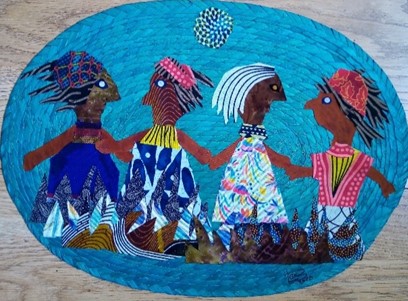
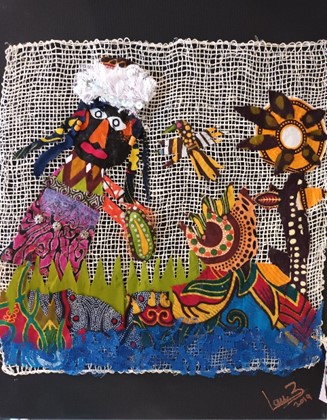
The Black dolls in my life are a symbol of identity, struggle, and very strong love. They are a representation of a constant fight for the inequalities and injustices that Afro-descendant women have and continue to suffer. They have prompted me to shout out loud for their defense, for their recognition, for their rights, and for their love. Black dolls are in my heart.
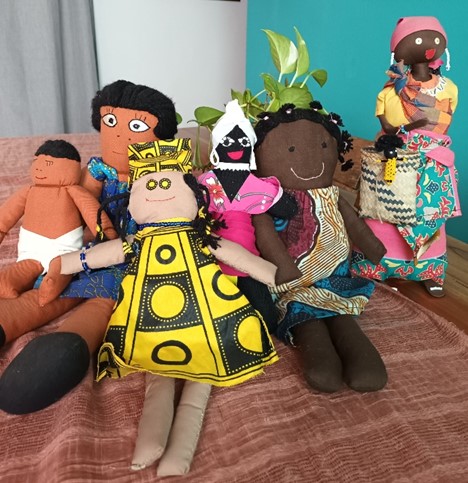
Cited Literature
INEGI (2020). Censo de Población y Vivienda 2020. Subsistema de Información Demográfica y Social. México. https://www.inegi.org.mx/programas/ccpv/2020/
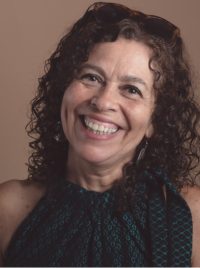
Laura Barraza-PhD in Education from the University of Cambridge, United Kingdom. For the last 40 years, she has dedicated her professional life to working in the fields of Education for sustainability, indigenous knowledge systems, environmental values, scientific education, decision-making processes with women and vulnerable groups in different regions of Mexico, the United Kingdom, Australia, and Africa. She is Director of Sustainable Education at SACBÉ - Environmental Services, Biological Conservation and Education A.C. from Mexico. As well as, International consultant in Socio-Environmental Affairs and specialist in Conservation Education for countries in Latin America, Australia, and Africa. *Photos courtesy of the author.
